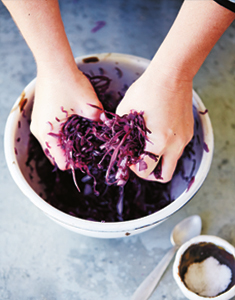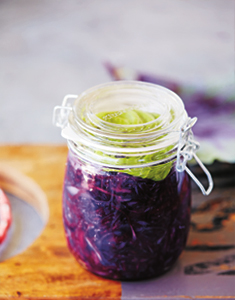
SAUERKRAUT
If you’re interested in fermenting your own vegetables, this is the perfect place to begin. Surprisingly versatile and easy to prepare, sauerkraut is a perfect addition to your kitchen – and making your own rather than buying it from the supermarket yields a much tastier result and is significantly cheaper. I always have a jar of this in the fridge to have on a grilled cheese sandwich, alongside barbecued meats, or to serve with smoked meats and crackers before a meal.
I’ve detailed a process here, rather than a strict recipe; the only way you’ll really learn how to make sauerkraut is to simply get into it. The quantity of ingredients here will make a small batch, so don’t fear that you’ll have bottle upon bottle of the stuff. A 1 litre (32 oz) jar, or two smaller ones, is perfect to get you started.
Sauerkraut is safe to eat at every stage of the process, so there’s no real minimum or maximum fermentation time. Start tasting after a few days, and when you are happy with how it tastes, pop it in the fridge and enjoy. I like it after about a week, but some people leave it for months and love the really funky taste. It’s up to you!
MAKES: 1 x 1 litre (32 oz) jar, or 2 x 500 ml (16 oz) jars
INGREDIENTS
1 kg (2 lb 4 oz) cabbage
1 tablespoon sea salt
EQUIPMENT
1 x 1 litre (32 oz) wide-mouthed jar and lid, or 2 x 500 ml (16 oz) jars and lids
sharp knife or mandoline
large bowl
rolling pin (optional)
SAUERKRAUT METHOD

1. |
Clean your jar: Wash your jar (or jars) in hot soapy water and leave to air dry. Prepare the cabbage: Discard the tough outer leaves of the cabbage. Slice the rest very thinly using a sharp knife or a mandoline; it should look like thin ribbons. |

2. |
Combine the cabbage and salt: This is where you need to get your hands wet and messy. Place the cabbage in a large bowl. Add the salt. Begin crushing the cabbage like you are giving it a good shoulder massage. After about 3 minutes of crunching, liquid will start seeping out of the cabbage, which is what you want. Keep going until the cabbage mixture is dripping with liquid. This can take anywhere up to 10 minutes. |

3. |
Pack into the jar: Pack the cabbage mixture tightly into the jar, pushing down to release any air; the end of a rolling pin works well for this. The cabbage mixture should be covered by its own liquid. A good trick here is to place one of the larger discarded outer leaves of the cabbage on top to keep it submerged. You can also use a smaller jar filled with pebbles, or a small snap-lock bag filled with water. |

4. |
Cover and leave: Place the lid on loosely and leave at room temperature, checking every couple of days, pressing down to make sure the cabbage mixture is submerged in the liquid. Check in and store: Start tasting at about 3 days, and as soon as you are happy with the balance of sour and sweet, put the jar in the fridge. Once in the fridge, the sauerkraut will last for about 2 months. |
HOW TO USE
- Grate a small onion and a few carrots, then mix in a few tablespoons of sauerkraut for a delicious Polish-inspired salad that is perfect with meat.
- Enjoy on a simple grilled cheese sandwich.
- For a nourishing lunch, toss some through cooked brown rice, chickpeas, almonds, sunflower seeds, chopped tomato, cucumber, avocado, coriander (cilantro) and parsley, with a big lug of olive oil and lemon juice.